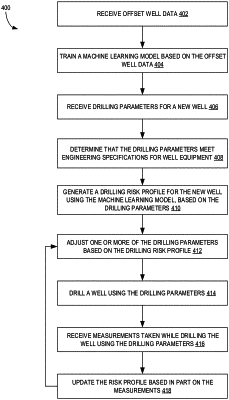| CPC G01V 1/50 (2013.01) [G06N 5/046 (2013.01); G06N 20/00 (2019.01); G01V 2200/16 (2013.01); G01V 2210/63 (2013.01)] | 18 Claims |

|
1. A method, comprising:
receiving offset well data collected while drilling one or more offset wells, the offset well data comprising data collected during drilling one or more wells that are offset from a well being planned;
generating a machine-learning model configured to predict drilling risks in the well being planned using drilling measurements or inferences based on the offset well data;
receiving drilling parameters for one or more drilling system components that are being evaluated for use in drilling the well being planned;
determining that the drilling parameters that are being evaluated are within engineering specifications for the one or more drilling system components;
using the machine-learning model, generating a projected drilling risk profile for the well being planned, the projected drilling risk profile quantifying projected drilling risks as a value representing a likelihood of one or more drilling risks being realized while drilling the well being planned using the drilling parameters that are being evaluated;
generating a visual representation of the projected drilling risk, the visual representation comprising the value representing the likelihood of one or more drilling risks being realized while drilling the well; while drilling the well using the drilling parameters:
receiving real-time drilling measurements;
inputting the real-time drilling measurements into the machine-learning model; receiving, from the machine-learning model, an updated drilling risk profile quantifying the drilling risks; and
displaying the updated drilling risk profile to one or more users and a comparison of the updated drilling risk with the projected drilling risk.
|